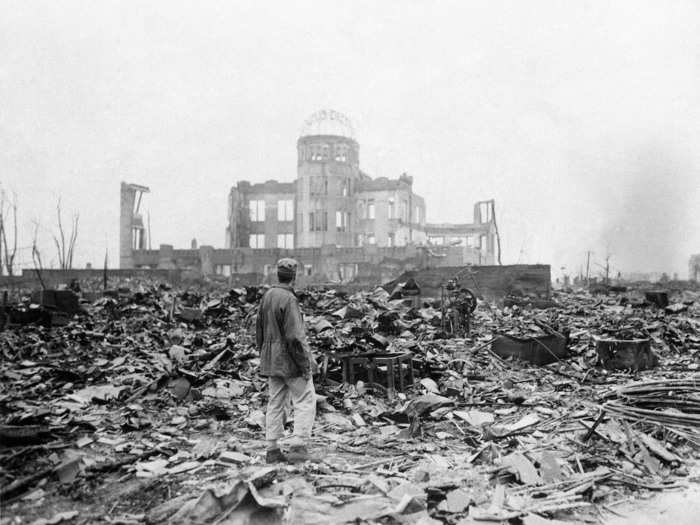
Almost 70% of buildings in Hiroshima were demolished in the blast. The skeleton of the Hiroshima Prefectural Industrial Promotion Hall, located only about 175 yards from the bomb’s hypocenter, stood starkly among the rubble and became a symbol of the devastation.

The Hiroshima Prefectural Industrial Promotion Hall, a multifunctional building created in 1915 that was used for research and design consultation, was one of the few buildings left standing after the blast.
Now a part of the Hiroshima Peace Memorial, the Atomic Bomb Dome, or Genbaku Dome, is a UNESCO World Heritage site.

The heat from the atomic blast burned lasting shadows onto walls and pavements in the shapes of the objects in its path. The most haunting Hiroshima shadows are the outlines of victims who were going about their daily lives when the bomb was dropped. Today, some shadows are displayed at the Hiroshima Peace Memorial Museum.

Sites in Hiroshima often draw peace activists. In 2005, Greenpeace members launched inflatable doves in front of the Atomic Bomb Dome on the day before the Hiroshima anniversary.

The routines of daily life in Hiroshima are much like any other large city in Japan. Visitors can enjoy okonomiyaki, a savory pancake the Visit Hiroshima website calls “Hiroshima’s soul food,” while exploring the city’s lively nightlife.
The city has launched a forward-looking planning process called Hiroshima 2045: City of Peace and Creativity, with a focus on designing a modern, distinctive urban landscape. Still, the memories of the past are never far away.

Hiroshi Harada, pictured in 2015 in front of the cenotaph, or memorial for those who died, in Peace Memorial Park, built near the epicenter of the 1945 bombing. Harada is a hibakusha, which is a term for survivors of the Hiroshima and Nagasaki bombings, and a former head of the Hiroshima Peace Memorial Museum.

In 2017, the International Campaign to Abolish Nuclear Weapons (ICAN) won the Nobel Peace Prize. Setsuko Thurlow, a hibakusha, gave a moving acceptance speech for the group in Oslo.
In 2018, Beatrice Fihn, ICAN executive director, (second from left) visited Hiroshima’s Peace Memorial Museum, which preserves artifacts and survivor stories in hopes of “No More Hiroshimas.”

Japanese Prime Minister Shinzo Abe lays a wreath during the Hiroshima Peace Memorial Ceremony at Hiroshima Peace Memorial Park on August 6, 2016 in Hiroshima, Japan.

In 2016, Barack Obama became the first sitting US president to travel to Hiroshima. He laid a wreath during a ceremony at Peace Memorial Park with Japanese Prime Minister Shinzo Abe and greeted Hiroshima bombing survivors.

In Hiroshima, on August 6, church bells ring at 8:15 am, the exact moment the bomb dropped. That begins a day of remembrance ceremonies that culminates in the hauntingly beautiful Toro Nagashi festival, where hundreds of lanterns are floated down the Motoyasu River, in front of the Atomic Bomb Dome.
Toro Nagashi began in Tokyo in 1946, and Hiroshima picked it up the following year. The lanterns are a tribute to those who perished in the bombing and an assurance that Hiroshima and the world will never forget what happened there on August 6, 1945.
 I quit McKinsey after 1.5 years. I was making over $200k but my mental health was shattered.
I quit McKinsey after 1.5 years. I was making over $200k but my mental health was shattered. Some Tesla factory workers realized they were laid off when security scanned their badges and sent them back on shuttles, sources say
Some Tesla factory workers realized they were laid off when security scanned their badges and sent them back on shuttles, sources say I tutor the children of some of Dubai's richest people. One of them paid me $3,000 to do his homework.
I tutor the children of some of Dubai's richest people. One of them paid me $3,000 to do his homework. Indo-Gangetic Plains, home to half the Indian population, to soon become hotspot of extreme climate events: study
Indo-Gangetic Plains, home to half the Indian population, to soon become hotspot of extreme climate events: study
 7 Vegetables you shouldn’t peel before eating to get the most nutrients
7 Vegetables you shouldn’t peel before eating to get the most nutrients
 Gut check: 10 High-fiber foods to add to your diet to support digestive balance
Gut check: 10 High-fiber foods to add to your diet to support digestive balance

Copyright © 2024. Times Internet Limited. All rights reserved.For reprint rights. Times Syndication Service.